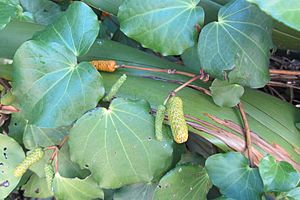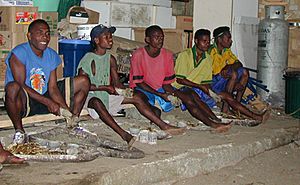Kava facts for kids
Quick facts for kids Kava |
|
|---|---|
 |
|
| Piper methysticum leaves | |
| Scientific classification | |
| Genus: |
Piper
|
| Species: |
methysticum
|
Kava or kava kava is a special plant from the Pacific Islands. Its scientific name is Piper methysticum. The word 'kava' comes from languages like Tongan and Marquesan, meaning 'bitter'. People in places like Hawaii, Vanuatu, Fiji, and Samoa have different names for it, such as ʻawa or yaqona.
People in Polynesia, Melanesia, and parts of Micronesia drink kava for its calming effects. The drink is made from the plant's root. It can make you feel relaxed and sometimes a bit numb. The main active parts of kava are called kavalactones.
Experts like the World Health Organization say that drinking kava in the traditional way (as a water-based drink from the roots) is generally safe. However, using kava extracts made with strong chemicals or too much poor-quality kava might cause health problems, including issues with the liver.
Contents
Kava's Journey: History and Names
Kava is a type of plant that was first grown by people in New Guinea or Vanuatu. Ancient sailors helped spread it across the Pacific. It became an important plant in Oceania, but it didn't reach New Zealand because it's too cold there for kava to grow.
The name 'kava' comes from an old language called Proto-Oceanic. It meant "bitter root." Over time, this word changed in different island languages. For example, in Hawaiian, it's ʻawa, and in Samoan, it's ʻava. In some languages, the word 'kawa' or 'kava' can also mean "bitter" or "sour."
What Kava Looks Like
Kava plants grow best in loose, well-drained soil where there's lots of rain. They like warm temperatures, usually between 70 and 95 degrees Fahrenheit (21-35 degrees Celsius), and lots of humidity. Kava plants don't like too much direct sunlight, especially when they are young.
Kava plants cannot make seeds to reproduce. Instead, new plants are grown from cuttings taken from existing stems. Farmers usually harvest kava when the plants are about four years old. Older plants have more of the special kavalactone compounds. Kava plants can grow up to 2 meters (about 6.5 feet) tall. Their roots can go as deep as 60 centimeters (about 2 feet).
Kava Varieties: Noble and Other Types
There are many different types, or "cultivars," of kava grown across the Pacific. Each type has its own growing needs and unique effects.
Noble Kava: The Best Choice
People who study kava talk about "noble" kava and "non-noble" kava. Noble kava is the traditional choice for regular drinking. It has a better mix of kavalactones and other compounds. This makes the effects more pleasant and reduces the chance of feeling sick, like nausea.
Non-noble kava includes types like "tudei" (meaning "two-day") kava. These types are usually only found in Vanuatu, where kava first came from. They are not traditionally used for everyday drinking. Some people believe that using non-noble kava in certain kava products might have caused some of the rare health problems reported in the past.
Because of these concerns, some countries like Vanuatu have rules about exporting kava. They only allow "noble" kava to be sent out of the country. This helps make sure that people around the world get good quality kava. Also, noble kava takes longer to grow (up to 5 years), while non-noble types can be harvested in just one year.
Where Kava Grows
In Vanuatu, kava exports are carefully controlled. Only "noble" types are allowed to be exported. Some popular noble kava types from Vanuatu include "Borogu" and "Melomelo." "Tudei" kava is kept for special ceremonies and is not allowed to be exported.
In Hawaii, there are also many types of kava, called ʻawa. Some well-known Hawaiian types are Mahakea and Moʻi.
Kava's Cousin: Kawakawa

The kawakawa plant (Piper excelsum) is sometimes called "Māori kava." It looks similar to kava and has a similar name, but they are different plants. Kawakawa is a small tree that grows in New Zealand. It's important in traditional Māori culture and medicine.
Early Polynesian travelers likely knew about kava. When they settled in New Zealand, they might have brought some kava plants with them. However, most of New Zealand is too cold for kava to grow. So, the Māori people used kawakawa instead. Kawakawa is used in Māori traditional medicine for skin problems, wounds, and stomach upsets. Even though it looks like kava and has a bitter taste, kawakawa does not have the same calming effects as kava.
What's Inside Kava Roots?
Fresh kava roots are mostly water (about 80%). When dried, the roots contain about 15% kavalactones. These are the special compounds that give kava its effects. Kavalactones are found mostly in the roots. The older the plant, the more kavalactones it usually has.
Kava roots are harvested after at least four years, or ideally five years, to get the most kavalactones. A mature kava plant can produce about 50 kilograms (110 pounds) of root. The roots are divided into "crown root" (larger pieces) and "lateral root" (smaller, more typical roots). Lateral roots have the highest amount of kavalactones.
How Kava is Prepared

Kava is enjoyed in many ways across the Pacific Islands. Traditionally, people prepare it by chewing, grinding, or pounding the roots.
To grind kava, people might rub the root against a rough stone. Then, they mix the ground root with a little cold water. The drink is usually consumed quickly.
The kava drink is a milky liquid. It tastes a bit strong, and its smell depends on whether it was made from fresh or dried kava, and what type of kava was used. The color can be gray, tan, or greenish.
Kava prepared in the traditional way is often stronger than processed kava. Chewing the roots makes the finest particles, which gives the strongest effect. Fresh kava also makes a stronger drink than dried kava.

Kava's Place in Culture
Kava is very important in the Pacific Islands. It's used for medicine, religious ceremonies, political meetings, and social gatherings. These cultures have deep respect for the kava plant and its traditions.
Why Kava is Important
For hundreds of years, people in the South Pacific Islands have used kava as a traditional medicine. They used it for breathing problems like asthma and coughs, for skin issues and wounds, and to help with pain.
Today, scientists are also studying kava to understand its potential calming and sleep-aiding properties. Some early studies suggest that kava might help with feelings of worry or anxiety.
Related Pages
- Piper hooglandii, another plant in the same family as kava.
Images for kids
See also
 In Spanish: Kawa-kawa para niños
In Spanish: Kawa-kawa para niños




